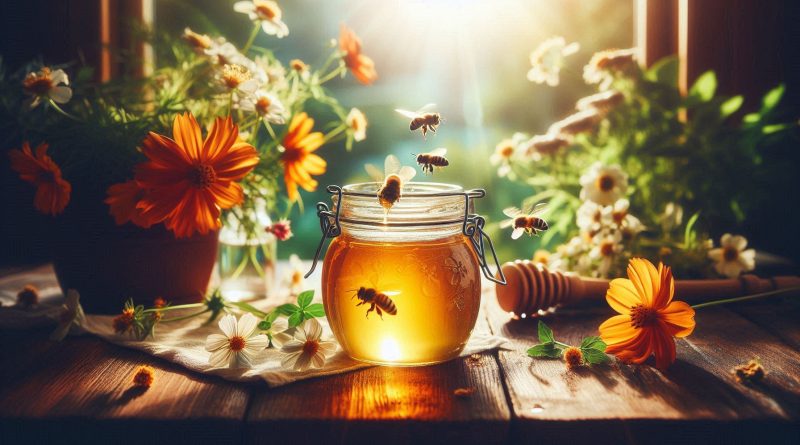Deep Dive into the Practical and Culinary Uses of Honey
Honey is not only a natural sweetener but also a versatile ingredient with applications that span cooking, baking, beverages, food preservation, and practical uses in everyday life. Its unique flavor, texture, and chemical properties make it indispensable in both culinary arts and practical contexts. Here’s an in-depth exploration of its uses:
1. Practical Uses of Honey
Honey’s natural composition and properties extend its utility beyond the kitchen. Its antimicrobial, humectant, and healing qualities make it a household staple.
A. Health and Wellness
- Cough Remedy:
- A teaspoon of honey can soothe sore throats and suppress coughs.
- Often combined with lemon and warm water for relief from cold symptoms.
- First Aid:
- Raw honey can be applied to minor burns, cuts, and wounds to speed healing and prevent infection.
- Skin Care:
- Used as a natural face mask for hydration, acne treatment, and reducing scars.
- Acts as a gentle exfoliant when mixed with sugar or oats.
- Hair Care:
- Combined with natural oils or conditioners to treat dryness, frizz, and scalp issues.
B. Natural Preservative
- Antimicrobial Action:
- Honey’s low water content and acidic pH inhibit microbial growth, making it an excellent preservative for jams, pickles, and marinades.
- Food Preservation:
- Ancient civilizations used honey to preserve fruits, meats, and other perishables.
C. Cleaning and Home Maintenance
- Natural Cleaner:
- Honey’s sticky texture attracts and traps dirt. Mixed with baking soda, it serves as a gentle scrub for household surfaces or utensils.
- Antibacterial Agent:
- Helps disinfect small tools or items when diluted with water.
D. DIY Beauty and Wellness
- Lip Balm:
- A mixture of honey and beeswax can create nourishing, homemade lip balms.
- Energy Boost:
- Honey is used as a quick, natural energy source for athletes or during workouts.
2. Culinary Uses of Honey
Honey’s sweet, floral, and slightly tangy profile pairs well with a wide variety of ingredients, making it a cornerstone in diverse cuisines and recipes.
A. Sweetening Agent
- Alternative to Refined Sugar:
- Honey is used as a natural sweetener in tea, coffee, and smoothies.
- Its lower glycemic index makes it a preferred choice for health-conscious consumers.
- Sweetened Beverages:
- Used in hot and cold drinks, such as lemonade, iced teas, and cocktails, to add a distinct flavor.
B. Baking
- Moisture Retention:
- Honey helps baked goods stay moist and fresh for longer periods.
- Flavor Enhancer:
- Adds depth and complexity to cakes, cookies, and bread.
- Pairs well with warm spices like cinnamon, nutmeg, and cloves.
- Caramelization:
- The natural sugars in honey caramelize beautifully, lending golden hues and a rich aroma to baked dishes.
Examples:
- Honey cake, honey-glazed donuts, or baklava.
C. Marinades and Glazes
- Tenderizing Meat:
- Honey acts as a natural tenderizer due to its acidity.
- Flavorful Glaze:
- Perfect for coating meats like chicken, pork, or salmon, creating a sweet and sticky crust when roasted or grilled.
Examples:
- Honey garlic chicken wings.
- Honey-glazed ham.
D. Salad Dressings and Sauces
- Balanced Sweetness:
- Honey balances the acidity in vinaigrettes, dressings, and marinades.
- Thickening Agent:
- Adds body and a touch of sweetness to dips and sauces.
Examples:
- Honey mustard dressing.
- Honey BBQ sauce.
E. Pairing with Dairy
- Cheese Pairings:
- Honey pairs beautifully with cheeses like brie, goat cheese, and blue cheese, enhancing their creamy and tangy flavors.
- Yogurt and Desserts:
- Drizzled over Greek yogurt, ice cream, or panna cotta for a decadent treat.
F. Enhancing Breads and Breakfast Dishes
- Bread Spreads:
- A classic addition to toast, pancakes, and waffles.
- In Dough:
- Used in bread recipes to add subtle sweetness and enhance the browning process during baking.
Examples:
- Honey butter, honey drizzled over French toast.
G. Confectionery
- Candy Making:
- Honey is a key ingredient in nougat, brittle, and honeycomb candy.
- Natural Sweetener:
- Used in granola bars, energy bites, and protein bars for sweetness and binding.
H. Fermentation and Alcohol
- Mead Production:
- Honey is fermented with water and yeast to create mead, one of the oldest alcoholic beverages.
- Cocktails:
- Used in syrups and infusions to sweeten cocktails like hot toddies or whiskey sours.
3. Regional and Cultural Culinary Uses
- Middle Eastern Cuisine:
- Integral in desserts like baklava and basbousa.
- Indian Cuisine:
- Used in Ayurvedic recipes and desserts like shahi tukda.
- Asian Cuisine:
- Honey soy sauce marinades are popular in Chinese and Japanese dishes.
- European Cuisine:
- Drizzled over cheeses or added to herbal teas.
4. Tips for Cooking with Honey
- Adjust Measurements:
- Replace sugar with honey at a ratio of 3:4 (¾ cup of honey for every cup of sugar).
- Reduce Liquid:
- Since honey contains water, reduce other liquids in the recipe by ¼ cup per cup of honey used.
- Lower Baking Temperature:
- Honey caramelizes quickly, so reduce the oven temperature by 25°F to prevent burning.
- Choose the Right Honey:
- Light Honey: Acacia or clover honey for delicate flavors.
- Dark Honey: Buckwheat or forest honey for bold, robust dishes.
5. Popular Honey-Based Recipes
- Honey Lemonade:
- A refreshing drink combining honey, lemon juice, and water.
- Honey-Glazed Carrots:
- Sweet and savory side dish with roasted honey-coated carrots.
- Honey Oat Bread:
- Wholesome bread enriched with the sweetness of honey.
- Honey Butter:
- A spreadable blend of softened butter and honey, perfect for bread or pancakes.
Conclusion
Honey’s versatility in both practical and culinary contexts makes it a staple ingredient and remedy. Its role as a natural sweetener, preservative, flavor enhancer, and health booster ensures its value across various cuisines and everyday uses. By incorporating honey thoughtfully, you can elevate your dishes and make use of its natural benefits in creative and sustainable ways.


